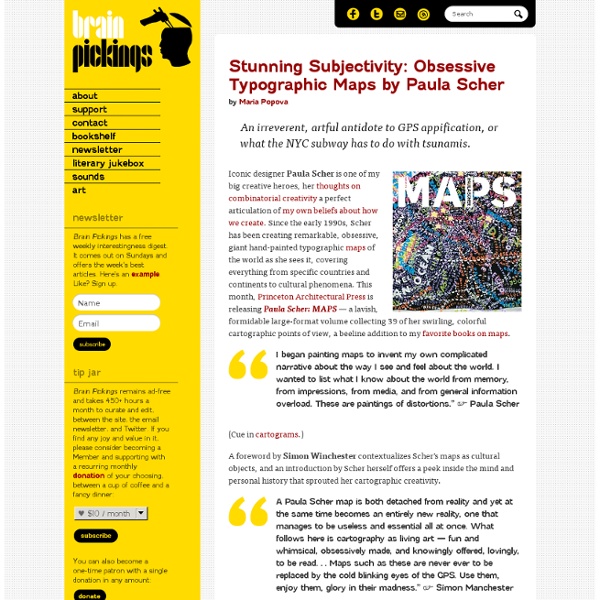Sightsmap
What Big Teeth You Have!
Of course, you already know the wolf's answer... This scary week continues with the last and most frightening installment of Animalarium's visual exploration of this enormously popular tale. See my previous posts here and here, and visit Shelley Davies for more Red Riding Hood goodness.
unecartedumonde.fr, cartes du monde, cartes de france, cartes détaillée.
Journals – Danny Gregory
I am an author and creative director dividing my time between Los Angeles and New York. I am working on several projects with publishers and with clients while speaking at conferences and organizations here and in Europe. Before setting up this new bi-coastal life, I was Managing Director and Executive Creative Director of mcgarrybowen in New York. I helped build the agency, from its humble origins as a couple of dozen people sitting in a room looking at the phone and waiting for it to ring — to the global behemoth (1,000+ people, offices on three continents) it is today. Before that, I was Chief Creative Officer of Doremus, which I helped to turn from a 100-year-old tombstone shop into the B-to-B and Corporate Agency of the Year serving clients from Corning to Goldman Sachs. I built my skills as a marketer and a writer at some of the best agencies in the industry including Ogilvy, Young & Rubicam, and Hal Riney.
obgeographiques
Daniel Hertzberg Illustration
About/Contact E-Mail: daniel@danielhertzberg.com Telephone: 516-286-7585 Gerald & Cullen Rapp: Follow me on Twitter: @danielhertzberg Daniel grew up on Long Island in Bellmore, NY and later received his BFA from the Rhode Island School of Design. Clients include: Time Magazine, The New Yorker, The New York Times, Wall Street Journal, Rolling Stone, Wendy's, Sports Illustrated, ESPN the Magazine, Major League Baseball, Saatchi and Saatchi, GQ (Germany), Bloomberg BusinessWeek, The Washington Post, Boston Globe, Knopf, Cigar Aficionado, Annabelle (Switzerland), Harvard Business Review, Yale University Press, Reader's Digest All images on this site are © 2008-2013, Daniel Hertzberg.
Wind Map
An invisible, ancient source of energy surrounds us—energy that powered the first explorations of the world, and that may be a key to the future. This map shows you the delicate tracery of wind flowing over the US. The wind map is a personal art project, not associated with any company. We've done our best to make this as accurate as possible, but can't make any guarantees about the correctness of the data or our software. If the map is missing or seems slow, we recommend the latest Chrome browser. Surface wind data comes from the National Digital Forecast Database. If you're looking for a weather map, or just want more detail on the weather today, see these more traditional maps of temperature and wind.
about
Hey there. My name is Maria Popova and I’m a reader, writer, interestingness hunter-gatherer, and curious mind at large. I’ve previously written for Wired UK, The Atlantic, The New York Times, and Harvard’s Nieman Journalism Lab, among others, and am an MIT Futures of Entertainment Fellow. Maria Popova. Brain Pickings is my one-woman labor of love — a subjective lens on what matters in the world and why. Founded in 2006 as a weekly email that went out to seven friends and eventually brought online, the site was included in the Library of Congress permanent web archive in 2012. Here’s a little bit about my seven most important learnings from the journey so far. I think of it as LEGOs — if the bricks we have are of only one shape, size, and color, we can build things, but there’s a limit to how imaginative and interesting they will be. Please enjoy. For more on the ethos behind this labor of love, here is my On Being conversation with the wonderful and generous Krista Tippett:
MyGPSFiles
Select a command to get help. Then, click apply to execute it. If one track is selected, the command will apply only to this track. Else the command will apply to all tracks. Duplicate the track. Revert the track points order. Create a new track by merging all tracks. Merge all track segments into one segment. Create a new track from each segment of the track. Reduce the number of track points. Reduce the number of track points to get a file with the requested size. Reduce the number of track points using the provided epsilon. Replace points elevations by the MapQuest elevation data. Replace points elevations by the Google Earth plugin elevation data. Add points to the track to get a more accurate elevation profile. Set the same elevation for all points. Increase or decrease the elevation of all points by the provided offset. Change the track start time (the first point time). Update points times to simulate the specified speed. Convert track into the selected format. Remove all time data



